Kai Lu
DeepGo: Predictive Directed Greybox Fuzzing
Jul 29, 2025Abstract:The state-of-the-art DGF techniques redefine and optimize the fitness metric to reach the target sites precisely and quickly. However, optimizations for fitness metrics are mainly based on heuristic algorithms, which usually rely on historical execution information and lack foresight on paths that have not been exercised yet. Thus, those hard-to-execute paths with complex constraints would hinder DGF from reaching the targets, making DGF less efficient. In this paper, we propose DeepGo, a predictive directed grey-box fuzzer that can combine historical and predicted information to steer DGF to reach the target site via an optimal path. We first propose the path transition model, which models DGF as a process of reaching the target site through specific path transition sequences. The new seed generated by mutation would cause the path transition, and the path corresponding to the high-reward path transition sequence indicates a high likelihood of reaching the target site through it. Then, to predict the path transitions and the corresponding rewards, we use deep neural networks to construct a Virtual Ensemble Environment (VEE), which gradually imitates the path transition model and predicts the rewards of path transitions that have not been taken yet. To determine the optimal path, we develop a Reinforcement Learning for Fuzzing (RLF) model to generate the transition sequences with the highest sequence rewards. The RLF model can combine historical and predicted path transitions to generate the optimal path transition sequences, along with the policy to guide the mutation strategy of fuzzing. Finally, to exercise the high-reward path transition sequence, we propose the concept of an action group, which comprehensively optimizes the critical steps of fuzzing to realize the optimal path to reach the target efficiently.
MoQAE: Mixed-Precision Quantization for Long-Context LLM Inference via Mixture of Quantization-Aware Experts
Jun 09, 2025Abstract:One of the primary challenges in optimizing large language models (LLMs) for long-context inference lies in the high memory consumption of the Key-Value (KV) cache. Existing approaches, such as quantization, have demonstrated promising results in reducing memory usage. However, current quantization methods cannot take both effectiveness and efficiency into account. In this paper, we propose MoQAE, a novel mixed-precision quantization method via mixture of quantization-aware experts. First, we view different quantization bit-width configurations as experts and use the traditional mixture of experts (MoE) method to select the optimal configuration. To avoid the inefficiency caused by inputting tokens one by one into the router in the traditional MoE method, we input the tokens into the router chunk by chunk. Second, we design a lightweight router-only fine-tuning process to train MoQAE with a comprehensive loss to learn the trade-off between model accuracy and memory usage. Finally, we introduce a routing freezing (RF) and a routing sharing (RS) mechanism to further reduce the inference overhead. Extensive experiments on multiple benchmark datasets demonstrate that our method outperforms state-of-the-art KV cache quantization approaches in both efficiency and effectiveness.
MADLLM: Multivariate Anomaly Detection via Pre-trained LLMs
Apr 13, 2025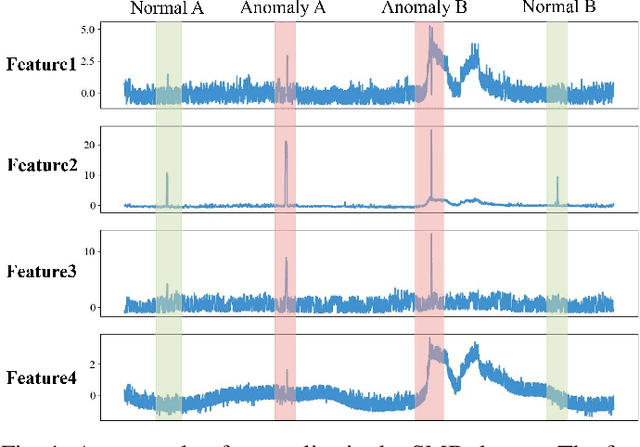
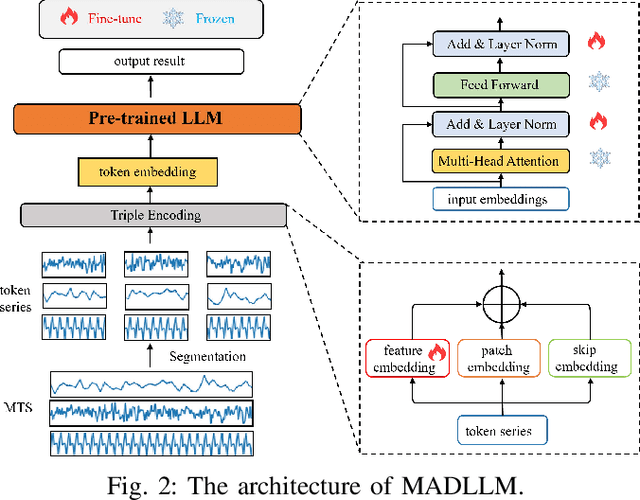
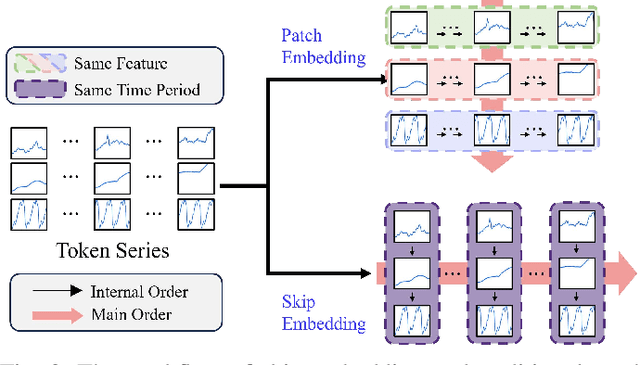

Abstract:When applying pre-trained large language models (LLMs) to address anomaly detection tasks, the multivariate time series (MTS) modality of anomaly detection does not align with the text modality of LLMs. Existing methods simply transform the MTS data into multiple univariate time series sequences, which can cause many problems. This paper introduces MADLLM, a novel multivariate anomaly detection method via pre-trained LLMs. We design a new triple encoding technique to align the MTS modality with the text modality of LLMs. Specifically, this technique integrates the traditional patch embedding method with two novel embedding approaches: Skip Embedding, which alters the order of patch processing in traditional methods to help LLMs retain knowledge of previous features, and Feature Embedding, which leverages contrastive learning to allow the model to better understand the correlations between different features. Experimental results demonstrate that our method outperforms state-of-the-art methods in various public anomaly detection datasets.
RUNA: Object-level Out-of-Distribution Detection via Regional Uncertainty Alignment of Multimodal Representations
Mar 28, 2025Abstract:Enabling object detectors to recognize out-of-distribution (OOD) objects is vital for building reliable systems. A primary obstacle stems from the fact that models frequently do not receive supervisory signals from unfamiliar data, leading to overly confident predictions regarding OOD objects. Despite previous progress that estimates OOD uncertainty based on the detection model and in-distribution (ID) samples, we explore using pre-trained vision-language representations for object-level OOD detection. We first discuss the limitations of applying image-level CLIP-based OOD detection methods to object-level scenarios. Building upon these insights, we propose RUNA, a novel framework that leverages a dual encoder architecture to capture rich contextual information and employs a regional uncertainty alignment mechanism to distinguish ID from OOD objects effectively. We introduce a few-shot fine-tuning approach that aligns region-level semantic representations to further improve the model's capability to discriminate between similar objects. Our experiments show that RUNA substantially surpasses state-of-the-art methods in object-level OOD detection, particularly in challenging scenarios with diverse and complex object instances.
RefSAM3D: Adapting SAM with Cross-modal Reference for 3D Medical Image Segmentation
Dec 07, 2024Abstract:The Segment Anything Model (SAM), originally built on a 2D Vision Transformer (ViT), excels at capturing global patterns in 2D natural images but struggles with 3D medical imaging modalities like CT and MRI. These modalities require capturing spatial information in volumetric space for tasks such as organ segmentation and tumor quantification. To address this challenge, we introduce RefSAM3D, which adapts SAM for 3D medical imaging by incorporating a 3D image adapter and cross-modal reference prompt generation. Our approach modifies the visual encoder to handle 3D inputs and enhances the mask decoder for direct 3D mask generation. We also integrate textual prompts to improve segmentation accuracy and consistency in complex anatomical scenarios. By employing a hierarchical attention mechanism, our model effectively captures and integrates information across different scales. Extensive evaluations on multiple medical imaging datasets demonstrate the superior performance of RefSAM3D over state-of-the-art methods. Our contributions advance the application of SAM in accurately segmenting complex anatomical structures in medical imaging.
Hammer: Towards Efficient Hot-Cold Data Identification via Online Learning
Nov 22, 2024Abstract:Efficient management of storage resources in big data and cloud computing environments requires accurate identification of data's "cold" and "hot" states. Traditional methods, such as rule-based algorithms and early AI techniques, often struggle with dynamic workloads, leading to low accuracy, poor adaptability, and high operational overhead. To address these issues, we propose a novel solution based on online learning strategies. Our approach dynamically adapts to changing data access patterns, achieving higher accuracy and lower operational costs. Rigorous testing with both synthetic and real-world datasets demonstrates a significant improvement, achieving a 90% accuracy rate in hot-cold classification. Additionally, the computational and storage overheads are considerably reduced.
InteLiPlan: Interactive Lightweight LLM-Based Planner for Domestic Robot Autonomy
Sep 22, 2024Abstract:We introduce a lightweight LLM-based framework designed to enhance the autonomy and robustness of domestic robots, targeting onboard embodied intelligence. By addressing challenges such as kinematic constraints and dynamic environments, our approach reduces reliance on large-scale data and incorporates a robot-agnostic pipeline. Our framework, InteLiPlan, ensures that the LLM model's decision-making capabilities are effectively aligned with robotic functions, enhancing operational robustness and adaptability, while our human-in-the-loop mechanism allows for real-time human intervention in the case where the system fails. We evaluate our method in both simulation and on the real Toyota HSR robot. The results show that our method achieves a 93% success rate in the fetch me task completion with system failure recovery, outperforming the baseline method in a domestic environment. InteLiPlan achieves comparable performance to the state-of-the-art large-scale LLM-based robotics planner, while guaranteeing real-time onboard computing with embodied intelligence.
See, Imagine, Plan: Discovering and Hallucinating Tasks from a Single Image
Mar 24, 2024



Abstract:Humans can not only recognize and understand the world in its current state but also envision future scenarios that extend beyond immediate perception. To resemble this profound human capacity, we introduce zero-shot task hallucination -- given a single RGB image of any scene comprising unknown environments and objects, our model can identify potential tasks and imagine their execution in a vivid narrative, realized as a video. We develop a modular pipeline that progressively enhances scene decomposition, comprehension, and reconstruction, incorporating VLM for dynamic interaction and 3D motion planning for object trajectories. Our model can discover diverse tasks, with the generated task videos demonstrating realistic and compelling visual outcomes that are understandable by both machines and humans. Project Page: https://dannymcy.github.io/zeroshot_task_hallucination/
Value-Driven Mixed-Precision Quantization for Patch-Based Inference on Microcontrollers
Jan 24, 2024
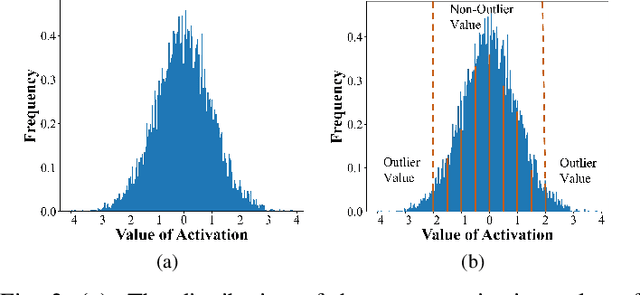
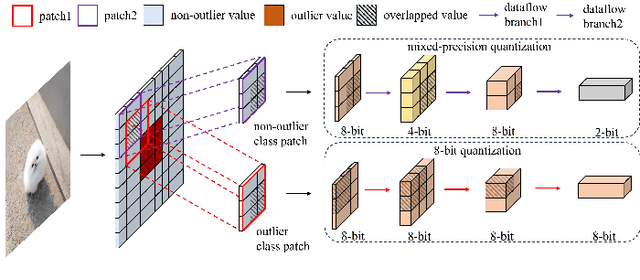
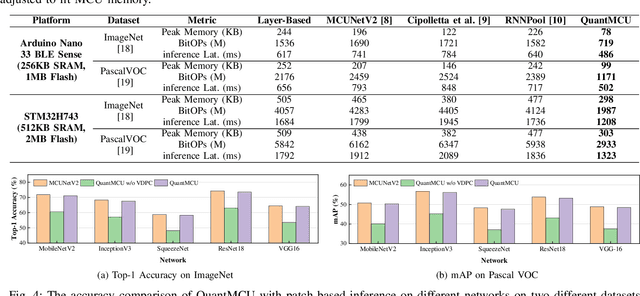
Abstract:Deploying neural networks on microcontroller units (MCUs) presents substantial challenges due to their constrained computation and memory resources. Previous researches have explored patch-based inference as a strategy to conserve memory without sacrificing model accuracy. However, this technique suffers from severe redundant computation overhead, leading to a substantial increase in execution latency. A feasible solution to address this issue is mixed-precision quantization, but it faces the challenges of accuracy degradation and a time-consuming search time. In this paper, we propose QuantMCU, a novel patch-based inference method that utilizes value-driven mixed-precision quantization to reduce redundant computation. We first utilize value-driven patch classification (VDPC) to maintain the model accuracy. VDPC classifies patches into two classes based on whether they contain outlier values. For patches containing outlier values, we apply 8-bit quantization to the feature maps on the dataflow branches that follow. In addition, for patches without outlier values, we utilize value-driven quantization search (VDQS) on the feature maps of their following dataflow branches to reduce search time. Specifically, VDQS introduces a novel quantization search metric that takes into account both computation and accuracy, and it employs entropy as an accuracy representation to avoid additional training. VDQS also adopts an iterative approach to determine the bitwidth of each feature map to further accelerate the search process. Experimental results on real-world MCU devices show that QuantMCU can reduce computation by 2.2x on average while maintaining comparable model accuracy compared to the state-of-the-art patch-based inference methods.
DynPoint: Dynamic Neural Point For View Synthesis
Oct 31, 2023



Abstract:The introduction of neural radiance fields has greatly improved the effectiveness of view synthesis for monocular videos. However, existing algorithms face difficulties when dealing with uncontrolled or lengthy scenarios, and require extensive training time specific to each new scenario. To tackle these limitations, we propose DynPoint, an algorithm designed to facilitate the rapid synthesis of novel views for unconstrained monocular videos. Rather than encoding the entirety of the scenario information into a latent representation, DynPoint concentrates on predicting the explicit 3D correspondence between neighboring frames to realize information aggregation. Specifically, this correspondence prediction is achieved through the estimation of consistent depth and scene flow information across frames. Subsequently, the acquired correspondence is utilized to aggregate information from multiple reference frames to a target frame, by constructing hierarchical neural point clouds. The resulting framework enables swift and accurate view synthesis for desired views of target frames. The experimental results obtained demonstrate the considerable acceleration of training time achieved - typically an order of magnitude - by our proposed method while yielding comparable outcomes compared to prior approaches. Furthermore, our method exhibits strong robustness in handling long-duration videos without learning a canonical representation of video content.
 Add to Chrome
Add to Chrome Add to Firefox
Add to Firefox Add to Edge
Add to Edge